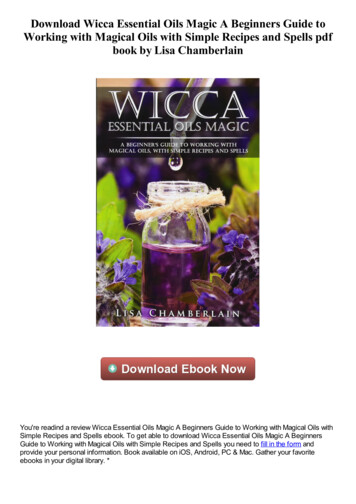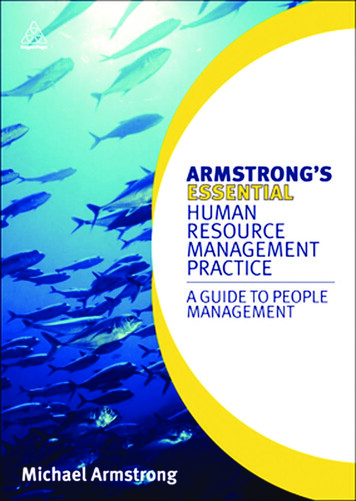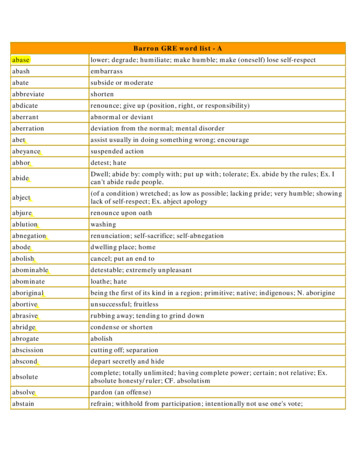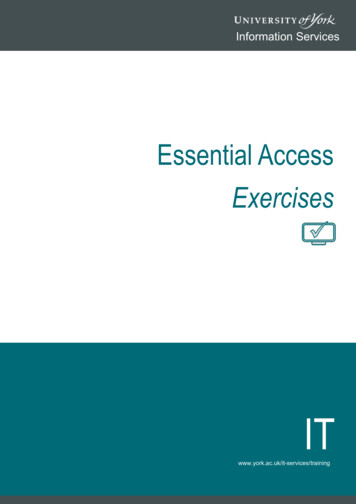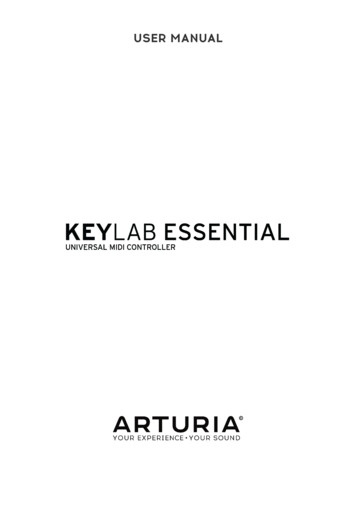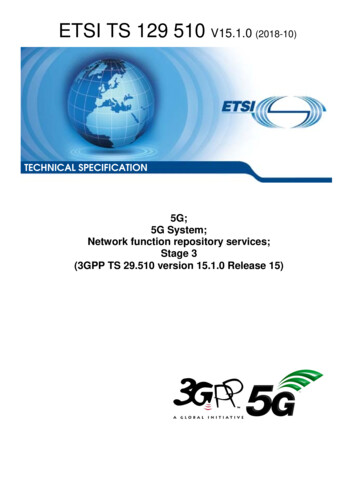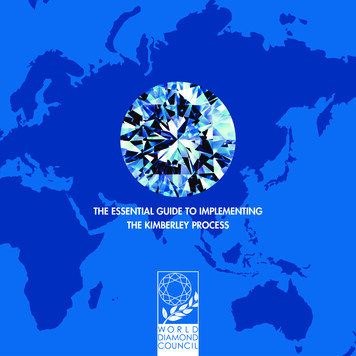
Transcription
THE ESSENTIAL GUIDE TO IMPLEMENTINGTHE KIMBERLEY PROCESS
The Essential Guide to Implementing the Kimberley ProcessThese guidelines have been prepared by the World Diamond Council on behalf of the World Federationof Diamond Bourses and the International Diamond Manufacturers’ Association.
Kimberley Process Certification Scheme& the System of WarrantiesIn order to fully combat the scourge of conflict diamonds, on November 5, 2002, fifty-two governmentsratified and adopted the final Kimberley Process Certification Scheme. In essence, these countries haveagreed that they will only allow for the import and export of rough diamonds if those rough diamondscome from or are being exported to another Kimberley Process participant.Participants in the Kimberley Process as of June 30, 2008 include:Angola, Armenia, Australia, Bangladesh, Belarus, Botswana, Brazil, Canada, Central African Republic,People’s Republic of China, Democratic Republic of Congo, Republic of Congo, Cote D’Ivoire (suspended),Croatia, European Community (Austria, Belgium, Czech Republic, Finland, France, Germany, Greece,Holland, Ireland, Italy, Luxembourg, Norway, Portugal, Spain, Sweden, United Kingdom), Ghana, Guinea,Guyana, India, Indonesia, Israel, Japan, Republic of Korea, Republic of Lao, Lebanon, Lesotho, Liberia,Malaysia, Mauritius, Namibia, New Zealand, Norway, Russian Federation, Sierra Leone, Singapore, SouthAfrica, Sri Lanka, Socialist Republic of Vietnam, Switzerland, Tanzania, Thailand, Togo, Turkey, Ukraine,United Arab Emirates, United States of America, Venezuela (suspended) and Zimbabwe.Rough Diamond ExportsThe Kimberley Process Certification Scheme requires that each shipment of rough diamonds being exportedand crossing an international border be transported in a tamper-resistant container and accompanied bya government-validated Kimberley Process Certificate. Each certificate should be resistant to forgery,uniquely numbered and include data describing the shipment’s content.The shipment can only be exported to a co-participant country in the Kimberley Process. No uncertifiedshipments of rough diamonds will be permitted to enter a participant’s country.1
Once a certified shipment has entered its country of destination it may be traded – in whole or part – andmixed with other parcels of rough diamonds as long as all subsequent transactions are accompanied bythe necessary warranties (see section below, “Industry Self-Regulation via a System of Warranties”).Failure to adhere to these procedures can lead to confiscation or rejection of parcels and/or criminalsanctions.Any rough diamonds being re-exported will also require Kimberley Process Certificates, which will beissued in the exporting country. These re-exports can comprise any combination of rough diamonds thathave been previously imported through the Kimberley Process Certification Scheme.Industry Self-Regulation via a System of WarrantiesIn order to strengthen the credibility of the Kimberley Process agreement, as well as to provide the meansby which consumers might more effectively be assured of the origin of their diamonds, the World DiamondCouncil proposed that the industry create and implement a System of Warranties for diamonds. Under thissystem, which has been endorsed by all Kimberley Process participants, all buyers and sellers of bothrough and polished diamonds must make the following affirmative statement on all invoices:“The diamonds herein invoiced have been purchased from legitimate sources not involved in fundingconflict and in compliance with United Nations resolutions. The seller hereby guarantees that thesediamonds are conflict free, based on personal knowledge and/or written guarantees provided by thesupplier of these diamonds.”In addition, each company trading in rough and polished diamonds is obliged to keep records of thewarranty invoices received and the warranty invoices issued when buying or selling diamonds. This flowof warranties in and warranties out must be audited and reconciled on an annual basis by the company’sown auditors. If asked for by a duly authorized government agency, these records must be able to provethat you are in compliance with the Kimberley Process.Additionally, all industry organizations and their members have adopted the following principles ofself-regulation:to trade only with companies that include warranty declarations on their invoices;to not buy diamonds from suspect sources or unknown suppliers, or which originate in countries thathave not implemented the Kimberley Process Certification Scheme;2
to not buy diamonds from any sources that, after a legally binding due process system, have been foundto have violated government regulations restricting the trade in conflict diamonds;to not buy diamonds in or from any region that is subject to an advisory by a governmental authorityindicating that conflict diamonds are emanating from or available for sale in such region, unlessdiamonds have been exported from such region in compliance with the Kimberley Process CertificationScheme;to not knowingly buy or sell or assist others to buy or sell conflict diamonds;to ensure that all company employees who buy or sell diamonds within the diamond trade are wellinformed regarding trade resolutions and government regulations restricting the trade in conflictdiamonds.Failure to abide by the aforementioned principles exposes the member to expulsion from industryorganizations.Under the terms of the Kimberley Process, it will be considered a violation to issue a warranty declarationon a sales invoice unless it can be corroborated by warranty invoices received for purchases.Failure to adhere to these principles will prompt investigation and could result in expulsion from the variousdiamond industry institutions.3
What Does This Mean for Each Sectorof the “Diamond Pipeline”?1. Mining companies and rough diamond buyers (at source)Rough diamonds may not be exported to a Kimberley Process participant unless the export country is aKimberley Process participant.Mining companies and rough diamond buyers operating in countries where the diamonds are firstrecovered wishing to export their shipments must ensure that:the country in which they operate is a participant of the Kimberley Process;the country to which they wish to export is also a participant.Further, as a minimum requirement, you will need to keep auditable records to demonstrate that the roughdiamonds in your shipment were either mined from your property and/or purchased from other legitimatesources (i.e., if the latter, the purchase must be accompanied by a warranty declaration).You will then need to notify the relevant exporting authority who will validate your shipment, prepare andprovide the necessary documentation – including a Kimberley Process Certificate– and seal your diamondsin a tamper-resistant container.The arrival of each export must be confirmed to the designated authority by the importer either electronicallyor by fax.Compliance with the Industry’s System of Warranties is also necessary and warranties must be included ineach sale and/or export of rough diamonds.4
Compliance Checklist1. Is the country from which you are exporting your diamonds a participant of the Kimberley Process ?2. Is the country you are exporting to a participant of the Kimberley Process ?If the answer is NO to either one or both of the above, you will not be able to export your diamonds.If the answer is YES to both questions, you may export your diamonds.Apply for export in the usual way, providing proof of origin and/or a warranty declaration.Once satisfied, the relevant government authority will ensure that your parcel is sealed according toKimberley Process regulations and will issue a Kimberley Process Certificate to accompany the parcel.2. Recipients of imported rough diamondsNo Kimberley Process participating country will allow the importation of rough diamonds unless it hasbeen exported from a Kimberley Process country in the prescribed manner.In order to import rough diamonds, the importer and exporter must both be from Kimberley Processcountries, you must receive a warranty and a Kimberley Process Certificate from the exporter and you mustconfirm receipt of the import with the designated authority exporter.Once you’ve taken receipt of the shipment, you are free to trade, divide and/or mix the diamonds as youwish, provided you receive or issue warranty invoices for each transaction.In addition, after January 1, 2003, each invoice of every transaction must be carried out under the directivesstated above and bear the following signed declaration:“The diamonds herein invoiced have been purchased from legitimate sources not involved in fundingconflict and in compliance with United Nations resolutions. The seller hereby guarantees that thesediamonds are conflict free, based on personal knowledge and/or written guarantees provided by thesupplier of these diamonds.”Compliance Checklist1. Is the country into which you are importing your diamonds a participant of the Kimberley Process ?2. Is the country you are importing from a participant of the Kimberley Process ?continued next page5
Compliance Checklist, cont’d3. Does the invoice carry warranties ?If the answer is NO to any or all of the above, you will not be able to import your diamonds.If the answer is YES to these questions, you may import your diamonds as follows:In most participating countries, your shipment will arrive as usual.Once satisfied that the container carrying your diamonds is intact and the Kimberley Process Certificateis in order, the relevant government authority will allow your parcel to enter the country.You are required to confirm with the exporter or designated authority upon receipt of your shipment thateverything is in order.You are now free to trade your diamonds as you wish, although you are obliged to adhere to diamondindustry regulations, as set out above, and provide your clients with a written warranty declarationon your invoices.3. Rough diamond dealers trading within a country’s bordersRough diamond dealers within a country will be expected to follow the same guidelines as mentionedabove, except for the necessity of Kimberley Process Certificates, which are used only for cross-bordershipments. Therefore, rough diamond dealers must ensure that they only purchase rough diamonds fromvendors who are able to provide an invoice with the System of Warranties declaration.Under the same industry regulations, they will be expected to keep records of the warrantiesaccompanying both purchases and sales and instruct their independent auditors (accountants) to verifyannually that these warranty records have been created and maintained accurately in the normal courseof business.Compliance ChecklistIs your vendor prepared and able to provide you with the System of Warranties declaration on theirinvoice for diamonds imported after January 1, 2003 ?If the answer is NO, you may NOT purchase their diamonds.If the answer is YES, you may purchase their diamonds.Keep a record of the warranties received and provided by you for your auditor’s annual inspection.6
4. Rough diamond dealers who wish to re-exportFor dealers and/or polishers and manufacturers who wish to re-export rough diamonds from countries orterritories into which they have already been imported under a Kimberley Process Certificate, anapplication for a Kimberley Process re-export certificate will have to be made.When presenting your shipment for re-export, you will need to assert to the relevant authority that thediamonds contained in the parcel have been traded and purchased in accordance with Kimberley Processrequirements. That is, they were originally imported under the Kimberley Process Certification Scheme andeach subsequent transaction was accompanied by a System of Warranties declaration. Essentially, youare required to maintain records of warranties given and warranties received. In order to re-export, youmust provide an invoice covering the shipment with the required industry warranty.As a minimum requirement, if asked by a duly authorized government agency, you must be able todemonstrate in an auditable manner that the diamonds contained in the shipment are covered by thenecessary warranties. Every year, your auditor must be able to verify that you have maintained accurateand reconcilable records of warranties received and warranties given.Compliance Checklist1. Do you meet the requirements for a Kimberley Process re-export certificate ?2. Have you maintained warranty invoices covering the purchases for the diamonds that you wish to re-export– remembering that the shipment might contain portions of several parcels that you may have purchasedand/or mixed?If the answer is NO, you may not re-export.5. Diamond polishers and manufacturersDiamond polishers and manufacturers, when dealing with rough diamonds, are subject to the sameguidelines as laid out in the sections on dealing with rough diamond dealers. Additionally, all sales ofpolished diamonds fall under the voluntary Industry System of Warranties. Therefore, each sale of polisheddiamonds will require a warranty invoice stating the following:7
“The diamonds herein invoiced have been purchased from legitimate sources not involved in fundingconflict and in compliance with United Nations resolutions. The seller hereby guarantees that thesediamonds are conflict free, based on personal knowledge and/or written guarantees provided by thesupplier of these diamonds.”You are required to maintain records of warranties received and warranties given. Further, on an annualbasis, your independent auditor must be able to verify that you have maintained records of warrantiesreceived and given.You are not required to apply for a Kimberley Process Certificate when exporting polished diamonds.6. Polished diamond dealers and jewelry manufacturersAll sales of polished diamonds fall under the voluntary Industry System of Warranties. Therefore, each saleof polished diamonds will require a warranty invoice stating the following:“The diamonds herein invoiced have been purchased from legitimate sources not involved in fundingconflict and in compliance with United Nations resolutions. The seller hereby guarantees that thesediamonds are conflict free, based on personal knowledge and/or written guarantees provided by thesupplier of these diamonds.”You are required to maintain records of warranties received and warranties given. Further, on an annualbasis, your independent auditor must be able to verify that you have maintained records of warrantiesreceived and given.You are not required to apply for a Kimberley Process Certificate when exporting polished diamonds.7. Diamond jewelry retailersRetailers have a crucial role to play in helping to ensure that the System of Warranties is both employedand effective.Retailers are therefore required to insist that their suppliers provide warranties for all diamonds polishedafter January 1, 2003. It is also recommended that retailers:inform your suppliers in writing that you will require a warranty;retain these warranties for at least five years.8
Diamonds Mined and/or PolishedPrior to January 1, 2003It is commonly understood by parties associated with the KimberleyProcess that there are billions of dollars worth of diamonds, both as roughand as polished, in existing inventories. Additionally, there is an evengreater volume of polished diamond jewelry owned by consumers, someof which may re-enter the market over time.Therefore, if you are purchasing diamonds that pre-date January 1, 2003, it is recommended that youensure, to the best of your ability, that these diamonds are from legitimate and known sources, preferablywith a statement from the seller attesting to this fact.If you are selling diamonds or jewelry that contains diamonds that pre-date January 1, 2003, you mustconsider using language such as:“The diamonds herein invoiced have been purchased prior to January 1, 2003 from sources that, to thebest of our knowledge, are reliable. The seller hereby guarantees that they have no personal knowledgeor reason to believe that these diamonds are involved in funding conflict and/or have been traded inviolation of any United Nations Resolution.”For all diamonds supplied to you with accompanying warranties stating that the diamonds were purchased inaccordance with Kimberley Process requirements, IF ASKED, retailers COULD state TO THEIR CUSTOMERS:“The diamonds herein invoiced have been purchased from legitimate sources not involved in fundingconflict and in compliance with United Nations resolutions. The seller hereby guarantees that thesediamonds are conflict free, based on personal knowledge and/or written guarantees provided by thesupplier of these diamonds.”If you are selling parcels of diamonds or jewelry with pre- and post-January 2003 stock, you may includeboth of the above statements in your invoice. However, you will still need to keep accurate records verifiedby your warranties of all transactions of post- January 1, 2003 diamonds. Of course, RETAILERS HAVE NOOBLIGATION TO INCLUDE THIS STATEMENT ON INVOICES TO CONSUMERS, BUT COULD MAKETHE STATEMENT, IF ASKED BY A CUSTOMER.Notwithstanding general compliance guidelines set forth above, all companies engaged in the trade ofdiamonds and/or diamond jewelry are urged to check with their national diamond office or appropriatenational trade association to determine what additional national regulations may apply.9
Background & History of the IssueWhat are “conflict diamonds”?In 1998, the world became aware that certain rebel movements in Africa were selling, among other things,illegally obtained diamonds – known as conflict diamonds – to fund their wars against legitimate andinternationally recognized governments.In 1998, the non-governmental organization (NGO) Global Witness first brought to the world’s attentionthe fact that UNITA, a rebel group in Angola, was funding its war against Angola’s legitimate governmentthrough the control, and subsequent sale, of rough diamonds. These rough diamonds have since becomeknown as conflict diamonds.Today, we also know that rebel groups in Sierra Leone and the Democratic Republic of Congo werealso funding their wars against the legitimate governments through the control, and subsequent sale, ofconflict diamonds.Most recently, with the establishment of peace in Sierra Leone and Angola and a cease-fire in theDemocratic Republic of Congo, the volume of conflict diamonds being traded is significantly lower.However, the diamond industry regards this as no reason for complacency and remains fully committed tointroducing measures and procedures that will protect legitimate channels of distribution from anypotential conflict diamond infiltration.What has been done to stop the trade in conflict diamonds?In 1998, and then in 2000, Global Witness and Partnership Africa Canada, two non-governmentalorganizations (NGOs) from the United Kingdom and Canada respectively, brought to the attention of thediamond industry and the world media that the illegal trade of rough diamonds was funding the activitiesof rebel organizations in Angola and Sierra Leone. This followed the imposition of comprehensiveeconomic and political UN sanctions on Angolan rebels mining diamonds in central Angola in June 1998.10
The diamond industry immediately began cooperating with the United Nations and engaged withgovernments and leading NGOs to seek ways to halt the trade in conflict diamonds.Progress to achieve this shared objective began in earnest in May 2000 when the South Africangovernment convened a meeting in Kimberley for all interested parties to meet and discuss a way forward.The meeting brought together, for the first time, governments, industry and NGOs. What followed was aseries of meetings, hosted by governments around the world, which came to be known as the KimberleyProcess . In December 2000, all 191 members of the United Nations General Assembly voted unanimouslyto support the process.Although these meetings were primarily inter-governmental, the diamond industry and NGO communitybecame active participants. It was the first time that a global industry had cooperated with the UnitedNations, governments and civil society to address an important humanitarian issue.Over a period of two years, an agreement on an International Certification Scheme was reached. Essentially,this scheme will ensure that official exports of rough diamonds from producing countries are dispatched intamper-resistant containers and accompanied by forgery-resistant certificates. Only countries with reciprocalarrangements would be able to import these consignments.In November 2002, the final draft of the Kimberley Process measures were ratified by more than fiftynations. It was agreed that implementation of the International Certification Scheme would take place onJanuary 1, 2003.It is an important proviso of the UN General Assembly resolution that established the Kimberley Processthat the measures introduced “do not place undue burden on the legitimate diamond trade.”At its peak in 1999, the trade in conflict diamonds accounted for less than four percent of the world’sannual rough diamond production. Although this was a relatively small amount, the international diamondindustry has declared that even one diamond traded in this way is one diamond too many.Action by the World Diamond CouncilAs industry awareness of conflict diamonds, as created by Global Witness and Partnership Africa Canada,grew, the industry became increasingly concerned about the grave human suffering being caused byseveral rebel organizations, partly funded by their illegal trade in diamonds. The industry recognized theclear moral and commercial imperatives and galvanized its members to present a united front in thecampaign to stop the trade in conflict diamonds.These concerns were addressed in detail at the 29th World Diamond Congress in July 2000. The WorldFederation of Diamond Bourses (WFDB) and the International Diamond Manufacturers’ Association (IDMA)11
issued a joint resolution declaring “zero tolerance” towards the trade in conflict diamonds. The resolutioncomprised a nine-point plan, providing practical measures to combat this trade, many of which have sincebeen adopted by the Kimberley Process.A key proposal set out in the joint resolution was the creation of a World Diamond Council (WDC) thatwould represent the entire diamond industry, from mining through to retail, at meetings of the KimberleyProcess. The WDC formed and held its inaugural meeting within two months in Israel.One of the most significant contributions to the Kimberley Process by the WDC has been the developmentof a form of self-regulation on behalf of the diamond industry called the System of Warranties. This industrydriven initiative has been designed to complement and support the International Certification Schemebeing developed by governments and is being implemented at the same time as the Kimberley Process.Essentially, this means that once a parcel of rough diamonds has been imported into a country under theKimberley Certification Scheme, each subsequent sales transaction that takes place with those diamonds mustinclude language on the invoice declaring that the diamonds have been purchased through authorizedchannels. These proposals were welcomed both by governments and non-governmental organizations.Although WFDB and IDMA have made this mandatory for the trade in rough diamonds, polished dealersand retailers are also being encouraged to adopt the system to ensure that the entire diamond pipelinefrom mine to jeweler is covered by an industry-wide system of warranties which can provide the consumerwith assurance that the diamonds purchased are, indeed, conflict-free.These measures have been negotiated by the WDC on behalf of the industry in order to meet the requirementof the international community that action be taken to halt the trade in conflict diamonds without placingundue burden on the industry. These measures are the minimum standards acceptable to all parties.Diamonds and economic developmentThe international diamond industry employs some two million people around the world, many in thirdworld and developing countries. The vast majority of the world’s diamonds come from sources that aiddevelopment and provide sustainable employment. Diamonds, like other natural resources, are vital to theeconomic development of a number of countries in Africa and elsewhere in the world. Given goodgovernance and the rule of law, diamonds are a vital source of revenue for the building of infrastructureand essential social services. The measures agreed on by the industry within the Kimberley Process aredesigned to protect the interests of all countries with diamond interests, whether they be producing,processing or consuming nations.For more information about the Kimberley Process and to view Kimberley Process Certificates,please visit www.kimberleyprocess.com or www.diamondfacts.org12
World Diamond CouncilEli IzhakoffChairman & CEO580 Fifth AvenueNew York, NY 10036U.S.A.Phone 1 212 575 8848Fax 1 212 840 0496Email: eli@diamondsview.comCecilia Gardner, Esq.General Counsel25 West 45th StreetSuite 1406New York, NY 10036-4902U.S.A.Phone 1 212 997 2002Fax 1 212 997 9148Email: mondfacts.org
www.kimberleyprocess.com 2 008 WORLD DIA MOND COUN CIL
The Essential Guide to Implementing the Kimberley Process . agreed that they will only allow for the import and export of rough diamonds if those rough diamonds . Socialist Republic of Vietnam, Switzerland, Tanzania, Thailand, Togo, Turkey, Ukraine, United Arab Emirates, Unit



